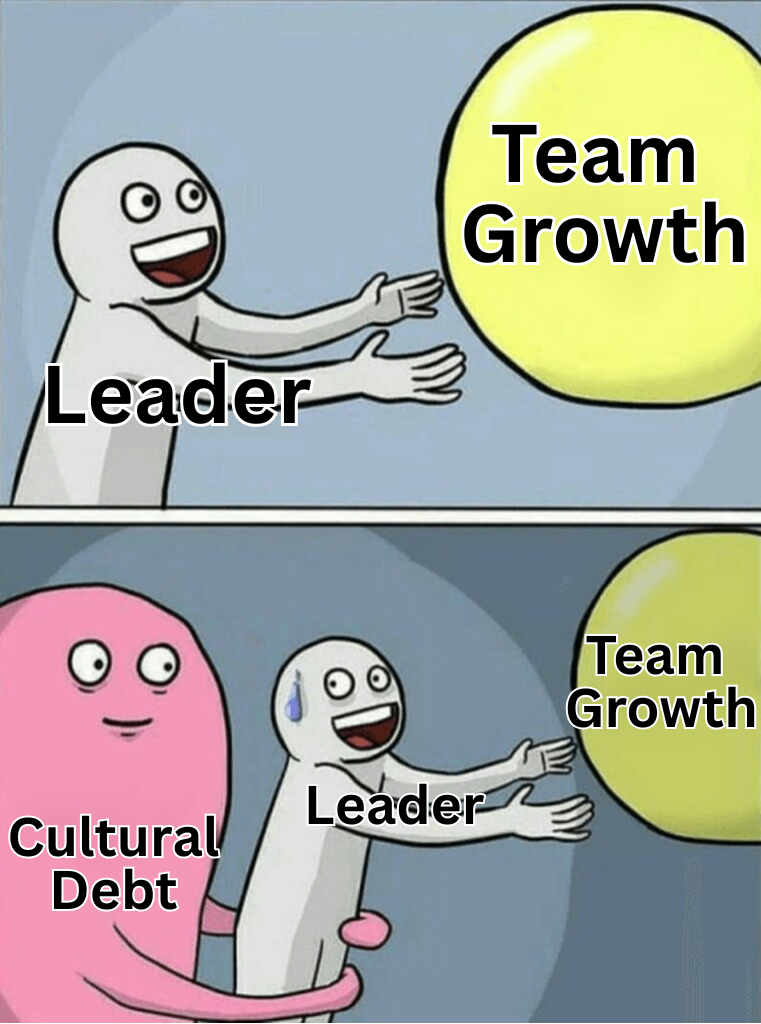The Danger of Cultural Debt
Every founder knows the pain of technical debt, but cultural debt is a more sinister and harder to fix issue.
When we talk about “debt” in tech companies, the conversation almost always centers on code. Every product team knows the trade-offs: cut corners now to ship, and you’ll pay later with bugs, inefficiencies, and potential rewrites. But there’s another kind of debt that is just as dangerous: cultural debt.
While technical debt slows down your product, cultural debt slows down your people. Left unchecked, it creates confusion, drains morale, and turns everyday decisions into political battles. If you want to scale well, you need to treat cultural debt with the same seriousness as technical debt: measure it, pay it down, and build practices that prevent it from compounding.
What Is Cultural Debt?
Cultural debt is the accumulation of unaddressed behaviors, norms, and misalignments that make your company less effective over time. Just like technical debt, it usually comes from shortcuts. It comes from taking the easy way over the right way too many times so a new standard becomes set.
Examples include:
Unclear communication norms: There is a lack of discipline around how the teams should be using Slack, email, or meetings creating tremendous noise and unclear approval pathways.
Undefined values: People reward “hero” behavior while saying they value sustainable, collaborative work.
Messy incentives: Compensation or promotions aren’t tied to what the company says matters.
Avoidance of conflict: Problems fester because people feel unsafe raising them.
Each of these may seem small in the moment, but they pile up. Soon you have a culture where decisions are slow, trust is low, and your best people are frustrated or leaving.
Why Cultural Debt Matters as Much as Technical Debt
It compounds silently: You can often see bugs in code, but cultural debt is like a slowly boiling frog that doesn’t notice what is happening until it is far too late.
It sets norms: The first ten hires don’t just build the product, they build precedent. If you ignore debt early, the bad patterns harden.
It impacts velocity: A messy culture is like working with spaghetti code. Every decision takes longer, basic communication is heavier, essential trust degrades, and the team is just not happy.
Leaders know technical debt is inevitable, but cultural debt is often not discussed. The truth: both are manageable if you take a realistic and proactive approach.
How to Identify Cultural Debt
Ask yourself:
Do your team members know your core values and reference them in decisions?
Is it clear how your team communicates, and does everyone actually follow those habits and norms?
Does your compensation and title structure reflect what you claim to value?
Do new hires onboard quickly and understand how things get done, or does it take months?
If the answer is “no” to any of these, you’re probably carrying cultural debt.
How to Pay Down Cultural Debt
Think of cultural debt as something you intentionally “refactor.” A few actionable ways:
Document the status quo: Write down the current standard, whether that’s values, decision-making, or communication. This does not need to be a drawn out process, simply document where you are starting from honestly and compare it to where you want to be.
Re-align incentives: Check your compensation, promotion, and recognition systems. Do they reward the behaviors you want? If not, fix them.
Clear the air: Run retrospectives, skip-level meetings, or “culture checks” to surface frustrations. Shine light on hidden friction before it calcifies.
Reset expectations: When you update a norm, communicate it directly. Cultural debt often comes from old habits hanging on after the company has grown.
Deputize cultural leaders: Team members up and down the org chart can impact culture. Find the powerful cultural magnets of the team who are outside leadership and work with them to drive change.
Final Thoughts
Every company carries debt. The question is whether you manage it or let it manage you. Technical debt will slow down your product, but cultural debt will slow down your people, and that’s far harder to fix later.
Treat culture with the same discipline you treat code. Identify it, refactor it, and prevent it from compounding. The sooner you start, the more resilient your company will be when growth inevitably tests its foundation.
